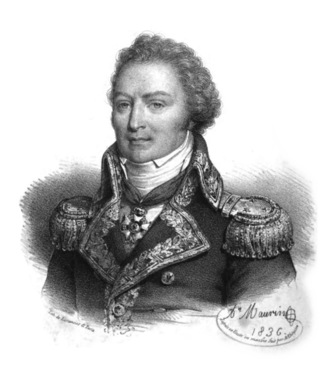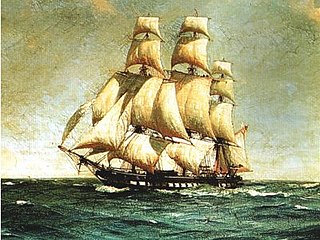Related Research Articles

Louis-René Madelaine Le Vassor, comte de La Touche-Tréville was a French admiral. He fought in the American War of Independence and became a prominent figure of the French Revolutionary Wars and of the Napoleonic wars.

Vice-Admiral Sir Henry Blackwood, 1st Baronet, whose memorial is in Killyleagh Parish Church, was an Irish officer of the British Royal Navy.
HMS Lively was a 32-gun fifth-rate Alcmene-class frigate of the British Royal Navy launched on 23 October 1794 at Northam. She took part in three actions – one a single-ship action, one a major battle, and one a cutting-out boat expedition – that would in 1847 qualify her crews for the issuance of the Naval General Service Medal. Lively was wrecked in 1798.

Jean-Baptiste Philibert Willaumez was a French naval officer and nobleman who served during the French Revolutionary Wars and Napoleonic Wars. Willaumez joined the French Navy at the age of 14, and proved to be a competent sailor. Having risen to the rank of pilot, he started studying navigation, attracting the attention of his superiors up to Louis XVI himself. Willaumez eventually became an officer and served under Antoine Bruni d'Entrecasteaux in his expedition to rescue Jean-François de Galaup, comte de Lapérouse and explore the Indian Ocean and Oceania.
The Aglaé was a 32-gun frigate of the French Navy, built to a design by P. Duhamel.

Pierre-François-Henri-Étienne Bouvet de Maisonneuve was a French Navy officer and privateer.

HMS Iphigenia was a Royal Navy 36-gun Perseverance-class fifth-rate frigate. She was built at Chatham Dockyard by Master Shipwright Robert Seppings.

Sensible was a 32-gun Magicienne-class frigate of the French Navy. The Royal Navy captured her in 1798 off Malta and took into service as HMS Sensible. She was lost in a grounding off Ceylon in 1802.
Captain Charles Berrenger was a French Navy officer.
Captain Jean-Marie Letellier was a French Navy officer.

L'Espoir was a French brig-sloop that served for 9½ years in the French Navy before HMS Thalia captured her in September 1797. In her subsequent short career in British service as HMS Espoir she captured three prizes, with the capture in 1798 of the more heavily armed Genoese pirate Liguria earning her crew a clasp to the Naval General Service Medal. Espoir was laid up in 1799 and sold in 1804.

Alceste was a Magicienne class frigate of the French Navy, launched in 1780, that the British seized at the Siege of Toulon. They transferred her to the Kingdom of Sardinia, but the French recaptured her a year later in the action of 8 June 1794. The British captured her again at the action of 18 June 1799 and took her into service as HMS Alceste. In 1801 she became a floating battery and she was sold the next year.
Jean-Michel Mahé was a French Navy officer and captain.

Louis-Charles-Auguste Delamarre, vicomte de Lamellerie was a French Navy officer and captain.
Jean-Joseph Hubert was a French Navy officer and captain.
Jean-Gilles Filhol de Camas was a French Navy officer and captain.

HMS Alert was launched in 1793 for the Royal Navy. In May 1794 the French Navy captured her and took her into service as Alerte. A few months later the Royal Navy destroyed her.

Robert was a 16-gun French privateer corvette launched in 1793 at Nantes. The British captured her in 1793 and named her HMS Espion. The French recaptured her in 1794 and took her into service as Espion. The British recaptured her in 1795, but there being another Espion in service by then, the British renamed their capture HMS Spy. She served under that name until the Navy sold her in 1801. Spy then became a slave ship in the triangular trade in enslaved people, a merchantman to South America, and privateer again. The French captured her in mid-1805 and sent her into Guadeloupe.

Décius was a Société populaire-class corvette launched in 1795 in Brest. Originally named Doucereuse, she was renamed to Décius in 1795. The British Royal Navy destroyed her in November 1796.
Louis-André Senez was an officer of the French Navy during the Revolutionary and Napoleonic wars.
References
- Quintin, Danielle; Quintin, Bernard (2003). Dictionnaire des capitaines de Vaisseau de Napoléon (in French). S.P.M. ISBN 2-901952-42-9.
- Roche, Jean-Michel (2005). Dictionnaire des bâtiments de la flotte de guerre française de Colbert à nos jours. Vol. 1. Group Retozel-Maury Millau. ISBN 978-2-9525917-0-6. OCLC 165892922. (1671-1870)
- Winfield, Rif (2008). British Warships in the Age of Sail 1793–1817: Design, Construction, Careers and Fates. Seaforth. ISBN 978-1-86176-246-7.